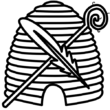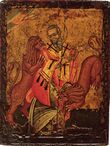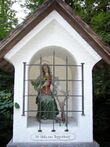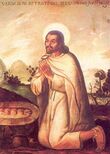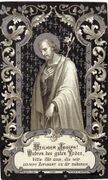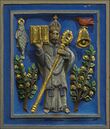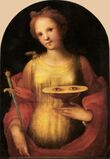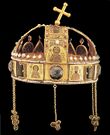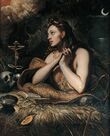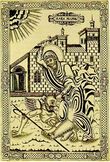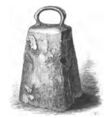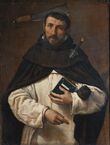Saint symbolism: Saints (I–P)
Saint symbolism has been used from the very beginnings of the religion.[1] Each saint is said to have led an exemplary life and symbols have been used to tell these stories throughout the history of the Church.[2] A number of Christian saints are traditionally represented by a symbol or iconic motif associated with their life, termed an attribute or emblem, in order to identify them. The study of these forms part of iconography in art history.[3] They were particularly used so that the illiterate could recognize a scene, and to give each of the Saints something of a personality in art.[2] They are often carried in the hand by the Saint.
Attributes often vary with either time or geography, especially between Eastern Christianity and the West. Orthodox images more often contained inscriptions with the names of saints, so the Eastern repertoire of attributes is generally smaller than the Western.[c] Many of the most prominent saints, like Saint Peter and Saint John the Evangelist can also be recognised by a distinctive facial type. Some attributes are general, such as the martyr's palm.[4] The use of a symbol in a work of art depicting a Saint reminds people who is being shown and of their story. The following is a list of some of these attributes.
Saints listed by name
Saints (A–H)
Saints (Q–Z)
I
Symbol for Isidore of Seville: beehive, crozier and quill
Ignatius of Antioch surrounded by lions
| Article title | Attributes |
|---|---|
| Ida of Toggenburg | Deer, or a deer with 12 candles, crow[5] |
| Ignacia del Espíritu Santo | Arms crossed in prayer with a rosary, needles, scissors, almsbaskets, dove, Betania retreat house[citation needed] |
| Ignacy Kłopotowski | Cassock[citation needed] |
| Ignatius Brianchaninov | Vested as a bishop[citation needed] |
| Ignatius of Antioch | bishops vestments, surrounded by lions or in chains[a] |
| Ignatius of Laconi | Franciscan habit[citation needed] |
| Ignatius of Loyola | Eucharist, chasuble, book often inscribed with Ad majorem Dei gloriam, or the letters AMDG, the christogram IHS with a cross across the h (traditionally with three nails below the letters, and the letters and nails surrounded by the sun's rays), sword, cross, biretta [a] |
| Ignatius of Santhià | Capuchin habit, rosary[citation needed] |
| Ignazia Verzeri | Religious habit[clarification needed] |
| Imelda Lambertini | Wearing first communion dress, chapel veil with attached to a chaplet of flowers on her head and rosary[citation needed] |
| Imerius of Immertal | hermit's garb and bird of prey[a] |
| Indaletius | miter, staff and a book in his hands[citation needed] |
| Inés de Benigánim | Religious habit of a Discalced Augustinian nun[citation needed] |
| Innocent XI | Papal attire, Papal tiara, camauro[citation needed] |
| Innocent of Alaska | Vested as a bishop, with a moderately long black beard, holding a Gospel Book or scroll[citation needed] |
| Innocenzo da Berzo | Capuchin habit[citation needed] |
| Inocencio of Mary Immaculate | Passionist habit and Passionist Sign[citation needed] |
| Irene of Rome | Tending to Saint Sebastian[citation needed] |
| Irene of Tomar | martyr's palm[a] |
| Irene Stefani | Religious habit of the Consolata Missionary Sisters[citation needed] |
| Irmã Dulce | Religious habit[clarification needed][citation needed] |
| Irmengard of Chiemsee | crozier of an abbess, flaming heart, Benedictine habit, crown[citation needed] |
| Irmina of Oeren | a church in her hand, signifying her status as a church founder; with two angels above her head, carrying her soul to heaven[citation needed] |
| Isaac of Dalmatia | Clothed as an Eastern monk, sometimes holding a scroll with a quotation from his hagiography, sometimes carrying a paterissa[citation needed] |
| Isaac of Nineveh | Scrolls and books, writing tools[citation needed] |
| Isabel Cristina Mrad Campos | Martyr's palm, Lily flower, rosary[citation needed] |
| Isaiah | With gray hair and beard holding a scroll with words from Isaiah 7, (in Latin) ecce virgo concipiet et pariet filium et vocabitur nomen eius Emmanuel (behold, a virgin shall conceive and bear a son, and his name shall be Emmanuel)[b] |
| Isabel Sánchez Romero | Dominican habit, crucifix[citation needed] |
| Isidore De Loor | Passionist habit[citation needed] |
| Isidore of Seville | bees; bishop holding a pen while surrounded by a swarm of bees; bishop standing near a beehive; old bishop with a prince at his feet; pen; priest or bishop with pen and book; with Saint Leander, Saint Fulgentius, and Saint Florentina; with his Etymologiae[a] |
| Isidore the Laborer | peasant holding a sickle and a sheaf of corn, a sickle and staff, as an angel plows for him; or with an angel and white oxen near him. In Spanish art, his attributes are a spade or a plough.[6] |
| Isnardo da Chiampo | Dominican habit[citation needed] |
| István Sándor (martyr) | book, Martyr's palm[citation needed] |
| Ivo of Kermartin | as a lawyer, holding a document, in legal dress[a] |
J
Saint Joseph holding a rod of spikenard
| Article title | Attributes |
|---|---|
| Jacques-Désiré Laval | Priest's attire[citation needed] |
| Jadwiga of Poland | Royal dress and shoes, apron full of roses[citation needed] |
| Jaime Hilario Barbal | Brothers' habit, Palm[citation needed] |
| Jakob Gapp | Priest's attire[citation needed] |
| Jakob Griesinger | Dominican habit[citation needed] |
| Jakub Strzemię | Archbishop's attire, Crozier[citation needed] |
| James the Less | carpenter saw, fuller's club[citation needed] |
| James Miller (religious brother) | Wrench[citation needed] |
| James of Sclavonia | Capuchin habit, Crucifix, Rosary[citation needed] |
| James of the Marches | Depicted holding in his right hand a chalice, out of which a snake is escaping[citation needed] |
| James the Great | Red Martyr, Scallop, Pilgrim's hat[citation needed] |
| James, brother of Jesus | Red Martyr, fuller's club; man holding a book[citation needed] |
| James, son of Alphaeus | Carpenter's saw; fuller's club[citation needed] |
| Jan Beyzym | Priest's cassock[citation needed] |
| Jan Franciszek Macha | Priest's cassock[citation needed] |
| Jan Sarkander | Priest's attire[citation needed] |
| Jan Tyranowski | Rosary[citation needed] |
| Jan Wojciech Balicki | Cassock[citation needed] |
| Janina Szymkowiak | Religious habit[citation needed] |
| János Brenner | Cistercian habit[citation needed] |
| Januarius | vials of blood, palms, Mount Vesuvius[citation needed] |
| Jean de Brébeuf | Pyx[citation needed] |
| Jean-Baptiste de La Salle | Book, Christian Brothers habit[citation needed] |
| Jean-Baptiste Fouque | Priest's attire[citation needed] |
| Jeanne-Antide Thouret | Religious habit[citation needed] |
| Jegudiel | Crown, whip[citation needed] |
| Jerahmeel (archangel) | Balance scales[citation needed] |
| Jeremiah of Wallachia | Franciscan habit[citation needed] |
| Jerome | hermitage, lion, hermit wearing a cardinal's galero, vestments of a cardinal, cross, skull, books and writing material, stone in hand[a] |
| Jerzy Popiełuszko | Crucifix[citation needed] |
| Joachim Piccolomini | Servite holding a book and flower[citation needed] |
| Joachim | Lamb, doves, with Saint Anne or Mary[citation needed] |
| Joan of Arc | shield, armament, Cross of Lorraine[a] |
| Joan of France, Duchess of Berry | crowned Annonciade abbess, usually with cross and rosary, or holding the hand of the Christ Child, who is holding a basket; Annonciade abbess with basket of bread and cup of wine; with Father Gabriel Mary; having a ring placed on her finger by the Christ Child[citation needed] |
| Saint Joanna | lamb[a] |
| Joaquina Vedruna de Mas | Religious habit[citation needed] |
| Job of Pochayev | Vested as a monk, holding an abbot's crozier[citation needed] |
| Joel (prophet) | Prophet[citation needed] |
| Johann Philipp Jeningen | Priest's cassock[citation needed] |
| Johannes Laurentius Weiss | Franciscan habit, Palm of martyrdom[citation needed] |
| Johannes Laurentius Weiss | Franciscan habit, Palm[citation needed] |
| Johannes Laurentius Weiss | Franciscan habit, Palm, crucifix[citation needed] |
| Johannes Ludovicus Paquay | Franciscan habit[citation needed] |
| John Berchmans | Rule of Saint Ignatius, cross, rosary[a] |
| John Berthier | Priest's cassock[citation needed] |
| John Bosco | Cassock, Biretta[citation needed] |
| John XXIII | Papal Vestments, Papal Tiara, Camauro[citation needed] |
| John Paul I | Papal attire, Pallium[citation needed] |
| John Paul II | Papal ferula, Papal vestments[citation needed] |
| John Calybite | Beggar with a Gospel in his hand[citation needed] |
| John Cantius | in a professor's gown with his arm around shoulder of a young student whose gaze is directed towards Heaven; giving his garments to the poor[citation needed] |
| John Chrysostom | Vested as a bishop, holding a Gospel Book or scroll, right hand raised in blessing. He is depicted as emaciated from fasting, with a high forehead, balding with dark hair and a small beard. Symbols: beehive, a white dove, a pan,[7] chalice on a bible, pen and inkhorn [a] |
| John Climacus | Clothed as a monk, sometimes with an Abbot's paterissa (crozier), sometimes holding a copy of his Ladder[citation needed] |
| John Eudes | Priest's attire, Sacred Heart[citation needed] |
| John Gualbert | Benedictine habit[citation needed] |
| John Henry Newman | Cardinal's attire, Oratorian Habit[citation needed] |
| John Joseph of the Cross | Franciscan habit[citation needed] |
| John Leonardi | Priest's cassock, Rule of the Order, quill, mortar and pestle[citation needed] |
| John of Damascus | Severed hand, icon[citation needed] |
| John of God | alms, heart, crown of thorns[a] |
| John of Matha | purse, man in Trinitarian habit, with the white with blue and red cross on the breast, with chains in his hands or at his feet, captives near him, and his mitre at his feet[citation needed] |
| John of Nepomuk | halo of five stars, palm, priestly dress, cross, bridge, angel indicating silence by a finger over the lips, Biretta[citation needed] |
| John of Sahagún | holding a Chalice and the Holy Host surrounded by rays of light[citation needed] |
| John of the Cross | Carmelite habit, cross, crucifix, book, and a quill[citation needed] |
| John Righi | Franciscan habit[citation needed] |
| John Soreth | Carmelite habit, ciborium[citation needed] |
| John the Apostle | Book, a serpent in a chalice, cauldron, eagle[citation needed] |
| John the Baptist | lamb, head on a platter, animal skin (the camel-skin coat of the Gospels), pointing at Christ or a lamb, often portrayed carrying a long crudely made cross[a] |
| John the Dwarf | Short Monk watering a stick[citation needed] |
| John the Evangelist | Eagle, Chalice, Scrolls[citation needed] |
| John the Merciful | Bishop's vestment, miter, crosier[citation needed] |
| John Twenge | fish, book, crozier, fur almice; muzzled animal at his feet[citation needed] |
| John Vianney | Cassock, surplice, preaching bands, stole, rosary, crucifix, and a Bible[citation needed] |
| Jón Ögmundsson | bishop's staff, miter, book[citation needed] |
| Jonathan (1 Samuel) | Bow and Arrow[citation needed] |
| Jophiel | Flaming sword[citation needed] |
| Jordan of Bristol | Youth, Roman, noble, the habit and tonsure of a monk, hand raised in blessing, bearing bread and wine,[8] companion of Augustine of Canterbury[9] |
| Jose Gabriel del Rosario Brochero | Priest's cassock, Rosary[citation needed] |
| José Gálvez Ginachero | Lab coat[citation needed] |
| José Gregorio Hernández | Doctor's coat[citation needed] |
| José Maria de Yermo y Parres | Priest's cassock[citation needed] |
| José Sánchez del Río | Crucifix, Palm branch[citation needed] |
| Josefa Naval Girbés | Carmelite habit[citation needed] |
| Josemaría Escrivá | Priest attire, rosary[citation needed] |
| Josep Manyanet i Vives | Priest's cassock[citation needed] |
| Josep Samsó Elías | Priest's cassock[citation needed] |
| Josep Tous Soler | Capuchin habit, Priest's cassock[citation needed] |
| Joseph of Anchieta | Gospel book, crucifix and Walking stick[a] |
| Joseph, spouse of Mary | Christ Child, white lily, rod, plane, carpentry square, often brown robe and/or mantle[a], holding a rod of spikenard[10] |
| Joseph Cafasso | Priest's attire[citation needed] |
| Joseph Calasanz | Cassock, biretta, and ferraiolo[citation needed] |
| Joseph Gérard | Priest's attire[citation needed] |
| Joseph Kugler | Religious habit[citation needed] |
| Joseph of Anchieta | Gospel Book, Crucifix and Cane[citation needed] |
| Joseph Oriol | Priest's cassock[citation needed] |
| Joseph Vandor | Priest's attire[citation needed] |
| Joseph Vaz | Mitre placed to side, holding crucifix, sun icon, Oratorian habit[citation needed] |
| Joseph Vithayathil | Religious habit[citation needed] |
| Joshua | Often depicted with Caleb, carrying the grapes out of Canaan[citation needed] |
| Jovan Vladimir | Cross, his own severed head, crown, and regal clothes[citation needed] |
| Juan de Castillo (Jesuit) | Palm of martyrdom[citation needed] |
| Juan de Prado | Franciscan habit, Sword, Fire[citation needed] |
| Juan de Ribera | Episcopal attire[citation needed] |
| Juan Diego | Tilma with the impressed image of the Virgin Mary, roses[a] |
| Juan García López-Rico | Trinitarian habit, Crucifix[citation needed] |
| Juan Manuel Martín del Campo | Cassock, Stole[citation needed] |
| Juan Nepomuceno Zegrí Moreno | Cassock[citation needed] |
| Juana de la Cruz Vázquez Gutiérrez | Brown habit of the Franciscan Third Order Regular Sisters, holding a large cross[citation needed] |
| Juana María Condesa Lluch | Religious habit[citation needed] |
| Jude the Apostle | Axe, club, boat, oar, medallion[citation needed] |
| Judoc | pilgrim's staff; a crown at his feet[citation needed] |
| Judicael | Warrior king holding a book, crown at his feet, sometimes with the Breton shield of arms[citation needed] |
| Julia Greeley | Rosary, Child, Tau cross[citation needed] |
| Julia of Corsica | Palm of martyrdom, crucifix[citation needed] |
| Julia Teresa Tallon | Religious habit[citation needed] |
| Julian and Basilissa | Palm of martyrdom[citation needed] |
| Julian of Antioch | portrayed as being cast into the sea in a sack full of serpents and scorpions. He may also be shown as his coffin floats with four angels seated on it, or being led bound on a dromedary.[citation needed] |
| Julian of Le Mans | Sometimes pictured as a bishop raising a dead child to life, also shown vanquishing a dragon[citation needed] |
| Julian of Norwich | holding a radiant cross, reading in her writing Revelations of Divine Love, wearing the attire of a anchoress[citation needed] |
| Julian the Hospitaller | Carrying a leper through a river; ferryman; hart; holding an oar; man listening to a talking stag; oar; stag; with Jesus and Saint Martha as patrons of travelers; young hunter with a stag; young man killing his parents in bed; young man wearing a fur-lined cloak, sword, and gloves; young, well-dressed man holding a hawk on his finger[citation needed] |
| Juliana Falconieri | represented in the habit of the Mantellates with a Eucharistic host upon her breast[citation needed] |
| Juliana of Liège | holding a monstrance[citation needed] |
| Juliana of Nicomedia | Represented in pictures with a winged devil whom she leads by a chain. She is also shown enduring various tortures or fighting a dragon.[citation needed] |
| Julian-Nicolas Rèche | De La Sallian habit[citation needed] |
| Julius of Novara | old priest with his staff, sailing on his cloak to Isola Giulio over a lake[citation needed] |
| Junia (New Testament person) | Christian Martyrdom[citation needed] |
| Junípero Serra | Franciscan habit, wearing a large crucifix, or holding a crucifix accompanied by a young Native American boy[citation needed] |
| Justa and Rufina | A model of the Giralda; earthenware pots, bowls and platters; books on which are two lumps of potter's clay; palms of martyrdom; lion[11] |
| Justin Popović | Shown holding a hagiography book[citation needed] |
| Justin Martyr | axe, sword[a] |
| Justina of Padua | martyr's palm, knife, unicorn[a] |
| Justina of Padua | young woman setting a cross on the head of the devil while holding a lily in her hand; young woman with a crown, palm, and sword; young woman with a palm, book, and a sword in her breast; young woman with a unicorn, symbolizing virginity, and palm; young woman with Saint Prosdocimus[citation needed] |
| Justinian I | Imperial Vestment[citation needed] |
| Justus of Beauvais | palm of martyrdom; depicted as young boy[citation needed] |
| Justus of Trieste | Spear, flowers across his chest and holding a palm and cathedral[citation needed] |
| Juthwara | round soft cheese, sword; with Sidwell; as cephalophore[a] |
| Juvenal of Narni | holding a sword in his mouth; holding a chalice[12] |
| Juvenaly of Alaska | Monastic habit, Epitrachelion, Cross[citation needed] |
K
| Article title | Attributes |
|---|---|
| Kateri Tekakwitha | turtle, white lily, cross, rosary [a][b] |
| Katharine Drexel | habit of the Sisters of the Blessed Sacrament[a] |
| Kakwkylla | Rats and mice[citation needed] |
| Kalliopi (martyr) | hot iron pressed to her breast[citation needed] |
| Kamen Vitchev | Assumptionist habit, cross, book[citation needed] |
| Karolina Gerhardinger | Religious habit of the School Sisters[citation needed] |
| Karolina Kózka | Lily flowers, martyr's palm, Rosary[citation needed] |
| Kaspar Stanggassinger | Priest's habit[citation needed] |
| Kateri Tekakwitha | Lily; Turtle; Rosary[citation needed] |
| Katherine of Ledbury | ringing bells,[13][14] the footprints of her stolen horse, clairvoyance,[15] herbs and milk[16] |
| Kentigern | bishop with a robin on his shoulder; holding a bell and a fish with a ring in its mouth[17] |
| Kea | hermit with a stag[citation needed] |
| Kessog | in a soldier's habit, holding a bow bent with an arrow in it[citation needed] |
| Kevin of Glendalough | blackbird[a] |
| Khalīl al-Haddād | Franciscan habit, rosary[citation needed] |
| Kilian | wearing a bishop's mitre and wielding a sword[a] |
| Kinga of Poland | Depicted as an abbess; crown[citation needed] |
| Kjeld of Viborg | cassock, book[a] |
| Knut of Denmark | royal insignia, dagger, lance or arrow.[a] |
| Koloman | pilgrim's hat and dress, rope in his hand; hanging on a gibbet; tongs and rod; book and maniple[b] |
| Kristos Samra | Woman with two-sided wings[citation needed] |
| Kuriakose Elias Chavara | Catholic saint, founder and social reformer[citation needed] |
L
| Article title | Attributes |
|---|---|
| Ladislas of Gielniów | Capuchin habit, Crucifix, Statue, Whip[citation needed] |
| Ladislaus I of Hungary | Holy Crown of St. Stephen I, Long sword, Two angels, Banner[citation needed] |
| Lambert of Maastricht | martyr's palm[a], sword[b] |
| Latuinus | episcopal attire[citation needed] |
| Laura Evangelista Alvarado Cardozo | Augustinian habit[citation needed] |
| Laura Montoya | Religious habit |
| Laureana Franco | Rosary, Catechism book[citation needed] |
| Lawrence of Rome | Usually holding a gridiron and wearing a dalmatic[b], cross, evangelistary, martyr's palm, purse of money, accompanied by a group of poor people[citation needed] |
| Lawrence of Brindisi | Leading soldiers against the Turks, With the Infant Jesus[citation needed] |
| Lazarus of Bethany | Sometimes vested as an apostle, sometimes as a bishop. In the scene of his resurrection, he is portrayed tightly bound in mummified clothes, which resemble swaddling bands.[citation needed] |
| Leander of Seville | episcopal attire, pen[a] |
| Leo I (emperor) | Imperial attire[citation needed] |
| Leobinus | depicted on his death-bed receiving the last rites from his successor Saint Caletric[citation needed] |
| Leocadia | Represented with a tower, to signify that she died in prison.[18] |
| Leodegar | Man having his eyes bored out with a gimlet, Bishop holding a gimlet, Bishop holding a hook with two prongs[citation needed] |
| Leonard Melki | Franciscan habit[citation needed] |
| Leonard of Noblac | depicted as an abbot holding chains, fetters or locks, or manacles.[19] |
| Leonard of Port Maurice | Franciscan habit[citation needed] |
| Leonardo Murialdo | Priest's attire, book[citation needed] |
| Leonella Sgorbati | Religious habit[citation needed] |
| Leonie Aviat | Religious habit[citation needed] |
| Léonie Martin | Nun's habit[citation needed] |
| Leopold III, Margrave of Austria | Holding a model of a church[citation needed] |
| Leopold of Alpandeire | Capuchin habit[citation needed] |
| Leopoldo da Gaiche | Crown of thorns, Franciscan habit, Crucifix[citation needed] |
| Leucius of Brindisi | Pastoral Staff[citation needed] |
| Leudwinus | Eagle[citation needed] |
| Lev of Optina | Clothed as a hieromonk, sometimes holding a scroll[citation needed] |
| Liberalis of Treviso | depicted as a knight[citation needed] |
| Liborius of Le Mans | pebbles on a book; peacocks; episcopal attire [20] |
| Liborius Wagner | Cassock, sword, palm[citation needed] |
| Lindalva Justo de Oliveira | Religious habit, Palm[citation needed] |
| Liphardus | Hermit fighting a dragon with a stick[citation needed] |
| Lodovico Pavoni | Cassock, Zucchetto[citation needed] |
| Lojze Grozde | book, palm, snowdrop[citation needed] |
| Longinus | Roman soldier's attire, lance [21] |
| Lorenzo da Ripafratta | Dominican habit[citation needed] |
| Lorenzo Maria of Saint Francis Xavier | Passionist habit, Image of the Child Jesus[citation needed] |
| Lorenzo Ruiz | Rosary in clasped hands, gallows and pit, barong tagalog and black trousers, cross, martyr's palm[a] |
| Louis Bertrand | A chalice containing a snake[22] |
| Louis Brisson | Priest's attire[citation needed] |
| Louis IX of France | royal attire of crown, sceptre, and blue mantle decorated with golden fleur-de-lis, and the other parts of the French regalia; crown of thorns, nails, 'globus cruciger[b] |
| Louis of Toulouse | silk gloves and a richly embroidered cape with a jeweled clasp at the neck[b], boy bishop, often with a discarded crown by his feet; represented vested in pontifical garments and holding a book and a crosier[citation needed] |
| Louis Querbes | Priest's cassock[citation needed] |
| Louis-Antoine-Rose Ormières Lacase | Priest's cassock[citation needed] |
| Louise de Marillac | Widow's clothing[citation needed] |
| Louise of France | Carmelite habit, rosary[citation needed] |
| Louis-Édouard Cestac | Priest's attire[citation needed] |
| Louis-Marie Baudouin | Cassock, Zucchetto[citation needed] |
| Luca Antonio Falcone | Franciscan habit, Rosary, Crucifix[citation needed] |
| Luca Passi | Priest's cassock[citation needed] |
| Lucrezia Elena Cevoli | Poor Clare habit, Crucifix[citation needed] |
| Lucy | robe of a virgin, with her eyes on a plate, lamp, sword[a] (also: Cord; woman hitched to a yoke of oxen; woman in the company of Saint Agatha, Saint Agnes of Rome, Barbara, Catherine of Alexandria, and Saint Thecla; woman kneeling before the tomb of Saint Agatha)[citation needed] |
| Lucy Brocadelli | Dominican habit, rosary[citation needed] |
| Lucy Filippini | Religious habit[citation needed] |
| Ludger | Bishop holding a cathedral; reciting his Breviary; with a swan on either side[citation needed] |
| Ludmila of Bohemia | veil[citation needed] |
| Ludovico Morbioli | Crucifix[citation needed] |
| Ludovico of Casoria | Franciscan habit[citation needed] |
| Ludwika Szczęsna | Religious habit, Crucifix, Heart[citation needed] |
| Luigi Biraghi | Cassock[citation needed] |
| Luigi Boccardo | Stole, cassock[citation needed] |
| Luigi Bordino | Sacred Heart[citation needed] |
| Luigi Caburlotto | Priest's cassock, Zucchetto[citation needed] |
| Luigi Guanella | Cassock[citation needed] |
| Luigi Lenzini | Priest's cassock[citation needed] |
| Luigi Maria Palazzolo | Priest's cassock[citation needed] |
| Luigi Monza | Cassock[citation needed] |
| Luigi Rabatà | Carmelite habit, arrow, martyr's palm[citation needed] |
| Luigi Scrosoppi | Priest's cassock, Book, Zucchetto,[citation needed]Rosary |
| Luigi Talamoni | Priest's attire[citation needed] |
| Luigi Tezza | Cassock, Cross[citation needed] |
| Luigi Variara | Cassock[citation needed] |
| Luigi Versiglia | Episcopal attire, martyr's palm, chalice[citation needed] |
| Luigia Poloni | Religious habit, Crucifix[citation needed] |
| Luka (Voyno-Yasenetsky) | Wearing bishop's vestment, pectoral cross and engolpion worn about his neck, miter and crozier.[citation needed] |
| Lupus of Troyes | depicted with a diamond falling from heaven as he celebrates Mass; shown holding a chalice with a diamond in it or at the altar, giving a diamond to a king[23] |
| Lutgardis | as Christ shows her his wounded side; habit and attributes of a Cistercian abbess; being blinded by the Heart of Jesus; nun to whom Christ extends his hand from the cross; in attendance when Christ shows his Heart to the Father[citation needed] |
| Luxurious | Palm branch[citation needed] |
M
Marina of Antioch beating a demon with a hammer
| Article title | Attributes |
|---|---|
| Macarius of Jerusalem | Bishop[citation needed] |
| Macarius, Metropolitan of Moscow | Vested as a bishop, holding a Gospel Book[citation needed] |
| Maddalena Caterina Morano | Religious habit[citation needed] |
| Maddalena Panattieri | Dominican habit, heart, rosary, Crown of thorns[citation needed] |
| Madeleine Sophie Barat | Religious habit, Book[citation needed] |
| Máedóc of Ferns | Honey bees[citation needed] |
| Mary Magdalene | jar of ointment, long hair, washing Christ's feet, skull, crucifix, red egg[a] |
| Magdalene of Canossa | Religious habit[citation needed] |
| Magdalene of Nagasaki | Palm, Augustinian habit (without the typical nun hair net, since she was a lay sister), books[citation needed] |
| Magnus Erlendsson, Earl of Orkney | Viking clothing, axe[citation needed] |
| Magnus of Anagni | episcopal attire, martyr's palm[citation needed] |
| Magnus of Cuneo | depicted as a soldier bearing a banner and the martyr's palm[citation needed] |
| Małgorzata Szewczyk | Religious habit, rosary[citation needed] |
| Malo (saint) | Depicted as an abbot and a bishop[citation needed] |
| Mamertinus of Auxerre | depicted lying in a cave surrounded by serpents or exhorting monks, lying on a mat in his cell before his death[citation needed] |
| Mami Wata | Snakes, pearls, gold, diamonds[citation needed] |
| Mamilian of Palermo | episcopal attire[citation needed] |
| Mammes of Caesarea | lion[citation needed] |
| Manuel Aparici Navarro | Priest's cassock[citation needed] |
| Manuel Domingo y Sol | Priest's cassock[citation needed] |
| Manuel Lozano Garrido | Newspaper, Rosary, Pen[citation needed] |
| Manuel Míguez González | Priest's attire[citation needed] |
| Manuel Solórzano | martyr's palm[citation needed] |
| Manuela de Jesús Arias Espinosa | Religious habit[citation needed] |
| Marcantonio Durando | Priest's cassock[citation needed] |
| Marcellinus and Peter | Depicted as two tonsured men holding crowns; martyr's palm; depicted alongside St. Pollio[24] |
| Marcello Labor | Priest's attire[citation needed] |
| Marcian of Tortona | martyr's palm[citation needed] |
| Marciana of Mauretania | represented as a maiden gored by a bull; sometimes depicted with a leopard and bull near her; martyr's palm[citation needed] |
| Marco da Montegallo | Franciscan habit[citation needed] |
| Marco d'Aviano | Franciscan habit[citation needed] |
| Marco Passionei | Franciscan habit, crucifix, book[citation needed] |
| Margaret of Castello | Dominican habit[citation needed] |
| Margaret of Hungary (saint) | A lily and a book[citation needed] |
| Margaret of Scotland | reading the bible[a] |
| Margaret Pole, Countess of Salisbury | martyr's palm, rosary, tunic bearing the Five Wounds of Christ[citation needed] |
| Margaret the Virgin | dragon, sometimes in chains, cross, hammer[a] |
| Margareta Ebner | Dominican habit[citation needed] |
| Margaretha Flesch | Religious habit[citation needed] |
| Margarito Flores García | palm[citation needed] |
| Margherita Colonna | Poor Clares habit[citation needed] |
| Marguerite Bays | rosary, Stigmata[citation needed] |
| Marguerite Rutan | Religious habit[citation needed] |
| Maria Adeodata Pisani | Benedictine habit, crucifix, bible[citation needed] |
| Maria Angela Astorch | Crosier, monstrance, breviary, Baby Jesus[citation needed] |
| Maria Angela Picco | Religious habit[citation needed] |
| María Angélica Pérez | Religious habit[citation needed] |
| Maria Anna Donati | Religious habit, crucifix[citation needed] |
| Maria Anna Rosa Caiani | Nun's habit[citation needed] |
| Maria Anna Sala | Religious habit[citation needed] |
| María Antonia Bandrés Elósegui | Religious habit[citation needed] |
| María Antonia de Paz y Figueroa | Religious habit, crucifix[citation needed] |
| Maria Assunta Pallotta | Religious habit[citation needed] |
| Maria Bagnesi | Dominican habit, crucifix, dagger[citation needed] |
| Maria Bernarda Bütler | Religious habit[citation needed] |
| Maria Candida of the Eucharist | Carmelite habit[citation needed] |
| María Catalina Irigoyen Echegaray | Religious habit[citation needed] |
| Maria Caterina Troiani | Nun's habit, crucifix[citation needed] |
| Maria Clara of the Child Jesus | Religious habit[citation needed] |
| Maria Costanza Panas | Franciscan habit[citation needed] |
| Maria Cristina of the Immaculate Conception Brando | Religious habit[citation needed] |
| Maria Crocifissa Curcio | Religious habit[citation needed] |
| Maria Crocifissa di Rosa | Religious habit[citation needed] |
| María de la Purísima Salvat Romero | Religious habit, rosary, Book of Hours[citation needed] |
| María de las Maravillas de Jesús | Discalced Carmelite habit, holding the rule of the order[citation needed] |
| Maria De Mattias | Foundress[clarification needed][citation needed] |
| María del Carmen González-Ramos García-Prieto de Muñoz | Religious habit[citation needed] |
| María del Tránsito Cabanillas | Religious habit[citation needed] |
| Maria Domenica Brun Barbantini | Religious habit[citation needed] |
| Maria Domenica Mantovani | Religious habit[citation needed] |
| Maria Dulce Rodrigues dos Santos | Nun's habit[citation needed] |
| Maria Elisabetta Renzi | Religious habit, crucifix[citation needed] |
| María Emilia Riquelme y Zayas | Religious habit[citation needed] |
| María Francisca Ricart Olmos | Religious habit[citation needed] |
| Maria Gargani | Religious habit[citation needed] |
| Maria Giovanna Fasce | Augustinian habit[citation needed] |
| Maria Giuseppa Rossello | Religious habit, book, lily[citation needed] |
| Maria Goretti | fourteen white lilies; humble clothing; (occasionally) a knife[a] |
| Maria Grazia Tarallo | Nun's habit, Scapular[citation needed] |
| María Guadalupe García Zavala | Religious habit[citation needed] |
| María Guggiari Echeverría | Discalced Carmelite habit[citation needed] |
| Maria Hueber | Religious habit[citation needed] |
| Maria Josefa Alhama y Valera | Religious habit[citation needed] |
| Maria Josefa Karolina Brader | Religious habit[citation needed] |
| María Josefa Sancho de Guerra | Religious habit, Sash, rosary[citation needed] |
| Maria Karłowska | Religious habit[citation needed] |
| Maria Katharina Kasper | Religious habit, crucifix[citation needed] |
| Maria Katherina Scherer | Religious habit[citation needed] |
| Maria Laura Mainetti | Martyr's palm, rosary[citation needed] |
| Maria Llorença Llong | Religious habit[citation needed] |
| María López de Rivas Martínez | Nun's habit, crucifix[citation needed] |
| Maria Maddalena Martinengo | Nun's habit, crucifix, rosary, White flowers[citation needed] |
| Maria Magdalena Jahn | Religious habit, rosary, crucifix[citation needed] |
| Maria Magdalena Merten | Religious habit[citation needed] |
| Maria Merkert | Religious habit[citation needed] |
| Maria Micaela Desmaisieres | Religious habit[citation needed] |
| María Natividad Venegas de la Torre | Nun's habit, heart[citation needed] |
| Maria Pia Mastena | Religious habit[citation needed] |
| María Pilar Izquierdo Albero | Religious habit[citation needed] |
| María Pilar López de Maturana Ortiz de Zárate | Religious habit[citation needed] |
| María Rafols Bruna | Religious habit[citation needed] |
| Maria Repetto | Religious habit[citation needed] |
| Maria Ripamonti | Religious habit[citation needed] |
| María Romero Meneses | Religious habit[citation needed] |
| Maria Schininà | Religious habit[citation needed] |
| Maria Scrilli | crucifix, Carmelite habit[citation needed] |
| Maria Soledad Torres y Acosta | Religious habit[citation needed] |
| Maria Teresa Casini | Religious habit[citation needed] |
| Maria Teresa Merlo | Religious habit[citation needed] |
| Maria Teresa of St. Joseph | Religious habit[citation needed] |
| Maria Therese von Wüllenweber | Nun's habit[citation needed] |
| Maria Theresia Bonzel | Nun's habit[citation needed] |
| Maria Troncatti | Religious habit[citation needed] |
| Maria Velotti | Religious habit[citation needed] |
| Maria Vicenta Rosal | Religious habit[citation needed] |
| Maria Vittoria De Fornari Strata | Religious habit[citation needed] |
| Mariam Baouardy | Carmelite Nun's habit[citation needed] |
| Mariam Thresia Chiramel | Religious habit[citation needed] |
| Mariam Vattalil | Religious habit[citation needed] |
| Mariana de Jesús de Paredes | Lily, black cassock embroidered with the Christogram of IHS[citation needed] |
| Mariana Navarro de Guevarra Romero | Religious habit, Cross, Lily, Heart[citation needed] |
| Marianna Fontanella | Carmelite habit, crucifix, White flower[citation needed] |
| Mariano Arciero | Priest's attire, crucifix[citation needed] |
| Mariano da Roccacasale | Franciscan habit[citation needed] |
| Mariano de Jesús Euse Hoyos | Priest's cassock[citation needed] |
| Mariano de la Mata | Priest's attire[citation needed] |
| Marie Anne Blondin | Religious habit[citation needed] |
| Marie Deluil-Martiny | Religious habit, Sacred Heart |
| Marie Laveau | Water, Roosters[citation needed] |
| Marie of Oignies | protected from rain by the Virgin Mary sheltering her with her mantle[citation needed] |
| Marie of the Incarnation (Carmelite) | Religious habit[citation needed] |
| Marie of the Incarnation (Ursuline) | Religious habit[citation needed] |
| Marie-Alphonsine Danil Ghattas | Religious habit, rosary[citation needed] |
| Marie-Anne-Marcelle Mallet | Religious habit[citation needed] |
| Marie-Clémentine Anuarite Nengapeta | Religious habit[citation needed] |
| Marie-Élisabeth Turgeon | Nun's habit, crucifix[citation needed] |
| Marie-Eugène de l'Enfant-Jésus | Carmelite habit[citation needed] |
| Marie-Eugénie de Jésus | Religious habit[citation needed] |
| Marie-Geneviève Meunier | Religious habit[citation needed] |
| Marie-Madeleine Postel | Religious habit, crucifix[citation needed] |
| Marie-Marguerite d'Youville | Religious habit[citation needed] |
| Marie-Rosalie Cadron-Jetté | Religious habit[citation needed] |
| Marinus | Depicted as a bearded layman with a stonemason's hammer; also depicted as a young deacon with a hammer; depicted serving as a deacon to Saint Leo the Great or Gaudentius of Rimini; two oxen near him.[citation needed] |
| Mario Ciceri | Priest's cassock[citation needed] |
| Mark of Ephesus | Long white beard, vested as a bishop, holding a scroll in one hand and Cross in the other[citation needed] |
| Markella | Martyr's palm, cross, scroll, (occasionally) being beheaded by her father.[citation needed] |
| Marko Krizin | Martyr's palm[citation needed] |
| Marta Anna Wiecka | Religious habit[citation needed] |
| Martha | broom, keys, tarasque,[25] aspergillum, dragon[a] |
| Martial | episcopal attire.[citation needed] |
| Martin de Porres | broom, a cat, dog and a mouse eating from the same plate[b] |
| Martin of Tours | geese; armament of a Roman soldier, sharing his cloak with a beggar[a] |
| Martina of Rome | palm of martyrdom[citation needed] |
| Martyrs of Libya | crown of martyrdom, orange jumpsuits, martyr's palm, crucifix[citation needed] |
| Martyrs of Albania | Palm[citation needed] |
| Martyrs of Algeria | Palm of martyrdom, Trappist habit[citation needed] |
| Martyrs of Jasenovac | Profession of faith, dove, martyr's palm, religious habit[citation needed] |
| Martyrs of Laos | Palm, Priest's cassock[citation needed] |
| Martyrs of Natal | Priest's attire, Palm branch[citation needed] |
| Martyrs of Prague | Franciscan habit, Palm branch[citation needed] |
| Martyrs of the Spanish Civil War | Crown of martyrdom, Martyr's palm, rosary[citation needed] |
| Martyrs of Zenta | Priest's cassock, Palm branch[citation needed] |
| Mary de Cervellione | Lily, boat, stormy sea[citation needed] |
| Mary Elizabeth Lange | Religious habit, rosary[citation needed] |
| Mary Frances Schervier | Religious habit[citation needed] |
| Mary Magdalene | Western: alabaster box of ointment; a skull on top of a book. Eastern: container of ointment (as a myrrhbearer), or holding a red egg (symbol of the resurrection); embracing the feet of Christ after the Resurrection[citation needed] |
| Mary of Bethany | Woman holding an alabaster jar of perfume (myrrh) and holding her hair[citation needed] |
| Mary of Jesus de León y Delgado | Dominican Religious habit, a rosary, the image of the Baby Jesus with laurel[citation needed] |
| Massacre of the Innocents | Martyr's palm, Crown of martyrdom[citation needed] |
| Materiana | crown; widow's robe.[citation needed] |
| Maurus | scales, spade, crutch[a] |
| Menas of Crete | two camels[a] |
| Mercurius | Martyr's palm[citation needed] |
| Mateo Elías Nieves Castillo | Cassock[citation needed] |
| Matilda | purse, alms[a] |
| Matilde Salem | brooch with the image of the Immaculate Conception[citation needed] |
| Matteo Ricci | Chinese Confucian scholar robes holding a crucifix and book[citation needed] |
| Matthias the Apostle | axe, Christian martyrdom[citation needed] |
| Mattia Ciccarelli | Augustinian habit, Eucharist[citation needed] |
| Mattia de Nazarei | Religious habit, book[citation needed] |
| Maurice | soldier in armour, soldier being executed with other soldiers, sub-saharan African in full armour, banner with red cross (the badge of the Order of Saints Maurice and Lazarus)[a] |
| Maurice Tornay | Augustinian habit[citation needed] |
| Maurice-Marie-Matthieu Garrigou | Cassock, Zucchetto[citation needed] |
| Maurus of Parentium | bishop holding the crown of martyrdom in his hand |
| Maurus, Pantalemon and Sergius | Mauro is represented in robes of a bishop with a book. Sergio and Pantaleone, in military attire, on a horse, while raising a flag with red cross on a white background[citation needed] |
| Maximilian Kolbe | Franciscan habit, the Rycerz Niepokalanej, Nazi concentration prison uniform, Nazi concentration camp badge, crucifix, rosary, and a palm of martyrdom[citation needed] |
| Maximin of Trier | depicted receiving Saint Athanasius at Trier; book; model of a church; bear at his side; commanding a bear to carry his things.[citation needed] |
| Maximus of Turin | depicted as a bishop pointing at a roe[citation needed] |
| Mechtilde | Scales and a sword, heart, book and dove[citation needed] |
| Medardus | Episcopal garments[citation needed] |
| Meinrad of Einsiedeln | two ravens[citation needed] |
| Melchor Chyliński | Franciscan habit[citation needed] |
| Menas of Egypt | Christian Martyrdom, man with his hands cut off and his eyes torn out; man with two camels; young knight with a halberd, an anachronistic depiction of his time in the Roman army[citation needed] |
| Menina Izildinha | Flowers[citation needed] |
| Mercè Prat i Prat | Teresian habit, Palm[citation needed] |
| Michael (archangel) | Archangel; treading on a dragon, carrying a banner, scales, sword, and weighing souls[a] |
| Michael de Sanctis | depicted kneeling before an altar where the Blessed Sacrament is exposed[citation needed] |
| Michael Hồ Đình Hy | Hanfu, Song official headwear, Martyr's palm, Dadao[citation needed] |
| Michael J. McGivney | Priest attire, Books, Rosary[citation needed] |
| Michał Giedroyć | crucifix[citation needed] |
| Michał Sopoćko | Cassock[citation needed] |
| Michel Garicoïts | Priest's attire[citation needed] |
| Michele Carcano | cross, skull[citation needed] |
| Michelina of Pesaro | Widow, pilgrim, and Franciscan tertiaries[citation needed] |
| Miguel Febres Cordero | Priest's cassock[citation needed] |
| Miguel Pro | Execution in a cruciform posture, Crown of martyrdom, Martyr's palm, rosary[citation needed] |
| Mildrith | Princess's crown, Abbess' crozier, hind[citation needed] |
| Miliau | depicted afs a cephalophore; in royal garb[citation needed] |
| Minias of Florence | Depicted as a young prince holding a crown; crowned with a rod and palm; crowned with a lily, rod and palm; carrying his severed head[c] |
| Miroslav Bulešić | Book, Palm, Priest's attire[citation needed] |
| Modomnoc | bees[citation needed] |
| Monica | girdle, tears[a] |
| Monon | Standing with a cow.[citation needed] |
| Moses | Tablets of the Law[citation needed] |
| Mother Teresa | Missionaries of Charity habit, rosary[citation needed] |
| Moura | Martyr's palm[citation needed] |
N
| Saint | Symbol |
|---|---|
| Nabor and Felix | two young men in military attire; palms[citation needed] |
| Nano Nagle | Monastic habit, Rosary[citation needed] |
| Narcissus of Jerusalem | Depicted as a bishop holding a thistle in blossom; pitcher of water near him, an angel depicted carrying his soul to Heaven[citation needed] |
| Natalina Bonardi | Religious habit[citation needed] |
| Nazaria Ignacia March Mesa | Religious habit[citation needed] |
| Nazarius and Celsus | depicted as a man and boy walking on the sea[26] |
| Nazju Falzon | Clerical cassock, Crucifix[citation needed] |
| Neagoe Basarab | Crown, Cross, Sword, Scroll, Hesychast[citation needed] |
| Nectarios of Aegina | Wearing a sakkos, omophorion worn about his shoulder, holding a book and epanokalimavkion[citation needed] |
| Nelson Lemus | Palm of martyrdom[citation needed] |
| Neot | fish[a] |
| Nestor of Magydos | Vested as a bishop, holding a Gospel Book, his right hand raised in blessing[citation needed] |
| Nicasius of Sicily | Military attire[citation needed] |
| Nicasius, Quirinus, Scubiculus, and Pientia | Dragon (Quirinus)[27] |
| Nicolás Factor | Franciscan habit, skull, fire [b] |
| Nicholas I | rooster[28] |
| Nicholas of Myra | Vested as a Bishop. In Eastern Christianity, wearing an omophorion and holding a Gospel Book. Sometimes shown with Jesus Christ over one shoulder, holding a Gospel Book, and with the Theotokos over the other shoulder, holding an omophorion, holding three golden balls or coins, crozier, anchor, boat, children, wheat sheaves[a] |
| Nicholas of Tolentino | Augustinian holding a bird on a plate in the right hand and a crucifix on the other hand; holding a basket of bread, giving bread to a sick person; holding a lily or a crucifix garlanded with lilies; with a star above him or on his breast[29] |
| Nicholas Pieck | Franciscan habit[citation needed] |
| Nicodemus the Hagiorite | Long white beard, monastic garb, often writing on a scroll, or in a book[citation needed] |
| Nicola da Forca Palena | Franciscan habit[citation needed] |
| Nicola da Gesturi | Capuchin habit[citation needed] |
| Nicola Mazza | Priest's attire, Children at his side[citation needed] |
| Nicola Paglia | Dominican habit[citation needed] |
| Nicola Saggio | Crucifix, habit of the Minims[citation needed] |
| Nicolás Factor | Franciscan habit, Skull, Fire[30] |
| Nicolò Cortese | Franciscan habit[citation needed] |
| Nicolò Politi | Staff[citation needed] |
| Nicolò Rusca | Crucifix[citation needed] |
| Nikolaj Velimirović | Vested as a bishop[citation needed] |
| Nikolaus Gross | Palm branch |
| Nimatullah Kassab | Religious habit, prayer rope[citation needed] |
| Ninian | Episcopal, clogrinny, or the Bell of St. Ninian[31][a] |
| Nino | Grapevine cross[citation needed] |
| Ninnoc | Religious habit, crosier, book, deer[citation needed] |
| Nonnosus | oil lamp or hanging lamp, rock,[32] depicted sometimes as a Benedictine monk (in black habit) or as an abbot with a staff or as a deacon wearing a dalmatic[33] |
| Norbert of Xanten | monstrance, cross with two beams[a][34] |
| Notburga | Ear of corn, or flowers and a sickle in her hand; sometimes the sickle is suspended in the air[citation needed] |
| Notker the Stammerer | A rod; Benedictine habit; book in one hand and a broken rod in the other with which he strikes the Devil[citation needed] |
| Nuno Álvares Pereira | Knight, sword, fleur-de-lis, Carmelite Habit, |
| Nunzio Sulprizio | Rosary, Anvil[citation needed] |
O
Saint Odile with larkspur
| Saint | Symbol |
|---|---|
| Obitius | depicted as a warrior on horseback[citation needed] |
| Oda of Scotland | wearing a long blue gown with one shoulder bare, carrying a staff or a book; magpie on her hand and a crown under her feet[a] |
| Odile of Alsace | Abbess praying before an altar; woman with a book on which lie two eyes[35] |
| Odo of Novara | Carthusian habit, Staff[citation needed] |
| Olaf of Norway | crown, axe, standing in a Viking boat[a] |
| Olinto Marella | Priest's cassock[citation needed] |
| Onesiphorus | Martyr's palm[citation needed] |
| Onuphrius | old hermit dressed only in long hair and a loincloth of leaves; hermit with an angel bringing him the Eucharist or bread; hermit with a crown at his feet[36][37] |
| Opportuna of Montreuil | carrying an abbess's crozier and a casket of relics. She may also be shown with the Virgin appearing at her deathbed or as a princess with a basket of cherries and a fleur-de-lys[38] |
| Origen | self-castration, monastic habit[citation needed] |
| Orontius of Lecce | Episcopal attire; smashes pagan idols at his feet[39] |
| Osanna of Mantua | Dominican tertiary wearing a crown of thorns and surrounded by rays of light; Dominican with the devil under her feet; a broken heart with a crucifix springing from it; a lily; two angels, one with a lily, one with a cross[citation needed] |
| Osgyth | Depicted carrying her own head, represented in art with a stag behind her and a long key hanging from her girdle, or otherwise carrying a key and a sword crossed, a device which commemorates St. Peter, St. Paul and St. Andrew[40] |
| Oswald of Northumbria | king in crown, carrying sceptre and orb, ciborium, sword, palm-branch, and/or with his raven[citation needed] |
| Othmar | Crozier and wine barrel[citation needed] |
P
| Article title | Attributes |
|---|---|
| Pachomius the Great | Hermit in a garb, Hermit crossing the Nile on the back of a crocodile[citation needed] |
| Pacificus of Ceredano | Franciscan habit[citation needed] |
| Pacificus of San Severino | Franciscan habit[citation needed] |
| Padre Pio | Stigmata, Franciscan habit, miracles, and sacerdotal vestments[citation needed] |
| Palladius of Embrun | episcopal attire[citation needed] |
| Pancras of Rome | Roman legion armour, martyr's palm branch, book, quill, sword[citation needed] |
| Pancras of Taormina | depicted as an old man with yellowing grey hair, vested as a bishop, holding a cross in his right hand, and a Gospel book in his left[citation needed] |
| Pancras | sword, martyr's palm[a] |
| Pantaenus | lecturing from a pulpit[citation needed] |
| Pantaleon | nailed hands[a] |
| Paola Gambara Costa | Franciscan habit[citation needed] |
| Paolo Manna | Priest's attire[citation needed] |
| Paraskevi of Iconium | Robe of martyrdom, vessel of perfume, Eastern cross, scroll[citation needed] |
| Pardus the Hermit | lion[citation needed] |
| Paschal Baylón | Monstrance, Franciscan habit, standing before the Eucharist[citation needed] |
| Patrick | cross, harp, serpent, baptismal font, demons, shamrock[a] |
| Patroclus of Troyes | depicted as a warrior pointing to a fish with a pearl in its mouth[citation needed] |
| Paul the Apostle | sword, book or scroll, horse, long, pointed beard, and balding backwards from forehead.[a] |
| Paul VI | Papal vestments, Papal tiara, Pallium[citation needed] |
| Paul Chong Hasang | Hanbok and gat, crucifix, palm of martyrdom[citation needed] |
| Paul Miki | palm, cross, spear[citation needed] |
| Paul of Taganrog | Monastic habit, Prosphora[citation needed] |
| Paul of the Cross | Passionist habit, crucifix[citation needed] |
| Paul of Thebes | Two lions, palm tree, raven[citation needed] |
| Paula Montal Fornés | Religious habit[citation needed] |
| Paula of Rome | Depicted as a Hieronymite abbess with a book, depicted as a pilgrim, often with Jerome and Eustochium, depicted prostrate before the cave at Bethlehem, depicted embarking in a ship, while a child calls from the shore, weeping over her children, with the instruments of the Passion, holding a scroll with Saint Jerome's epistle Cogite me Paula, with a book and a black veil fringed with gold, or with a sponge in her hand.[41] |
| Pauline Mallinckrodt | Religious habit[citation needed] |
| Pausicacus of Synada | Vested as a bishop[citation needed] |
| Pedro Armengol | Mercedarian habit, Rope|Palm of martyrdom[citation needed] |
| Pedro Calungsod | martyr's palm, spear, bolo, doctrina christiana book, rosary, christogram, crucifix[a] |
| Pedro de Arbués | Religious habit, Palm, Sword[citation needed] |
| Pelágio Sauter | Priest's attire[citation needed] |
| Penitent thief | Wearing a loincloth and either holding his cross or being crucified, sometimes depicted in Paradise[citation needed] |
| Pere Tarrés i Claret | Priest's cassock[citation needed] |
| Peregrina Mogas Fontcuberta | Religious habit[citation needed] |
| Peregrine (martyr) | Chi Rho on his chest, in a dungeon with the rack, the scourge, clubs or fire's flames[citation needed] |
| Peregrine Laziosi | one leg covered in a cancerous sore, a staff[citation needed] |
| Peregrine of Auxerre | converting pagans, overturning idols, founding Auxerre cathedral,[42] sometimes in the dress of a pilgrim in reference to his name (peregrinus means pilgrim in Latin), snake[43] |
| Perpetuus | Depicted as a bishop directing the building of a church. Sometimes the sick may be shown being healed at his tomb or as his relics are carried in procession[citation needed] |
| Petroc | Wolf, stag, church[citation needed] |
| Peter of Saint Joseph de Betancur | bell, Franciscan habit and the lance from the Shepherd's leap.[a] |
| Petar Zimonjić | Vested as a bishop[citation needed] |
| Peter and Fevronia of Murom | crown, sword, dove, scroll, white daisy, monastic habit[citation needed] |
| Peter Chanel | Gentle, kind, encouraging[citation needed] |
| Peter Damian | represented as a cardinal bearing a knotted rope in his hand, also as a pilgrim holding a papal Bull, Cardinal's hat, Benedictine habit[citation needed] |
| Peter de Regalado | Flames bursting from his heart[citation needed] |
| Peter Donders | Priest's attire[citation needed] |
| Peter Fourier | Chaplet, pictures of the Virgin Mary[citation needed] |
| Peter Friedhofen | Priest's attire[citation needed] |
| Peter González | Dominican holding a blue candle or a candle with a blue flame, Dominican lying on his cloak which is spread over hot coals, Dominican holding fire in his bare hands, Dominican catching fish with his bare hands, Dominican beside the ocean, often holding or otherwise protecting a ship[citation needed] |
| Peter Julian Eymard | Eucharist, Monstrance, Eucharistic Adoration, Eucharistic Congress, Cope, Humeral Veil, Congregation of the Blessed Sacrament, Servants of the Blessed Sacrament, Real Presence[citation needed] |
| Peter of Alcántara | Franciscan habit[citation needed] |
| Peter of Jesus Maldonado | priestly vestments, stole, palm, monstrance, Eucharist, Nocturnal Adoration pendant, Knight of Columbus pendant[citation needed] |
| Peter of Krutitsy | Vested as a bishop, right hand raised in blessing[citation needed] |
| Peter of Saint Joseph de Betancur | Holds a walking stick and bell. Occasionally it also represents a spear canary pastor.[44] |
| Peter of Verona | Dominican with a hatchet in his head or a severe head wound, or writing the words "Credo in Deum" as he dies[citation needed] |
| Peter the Aleut | portrayed as an Aleut youth, wearing a traditional gut parka[45] |
| Peter the Wonderworker | Vested as a bishop, holding a Gospel Book, right hand raised in blessing, making the Christogram ICXC[citation needed] |
| Peter To Rot | Martyr's palm, crucifix worn as a necklace, sometimes holding a globus cruciger[citation needed] |
| Petronius of Bologna | Depicted as a bishop holding a model of Bologna in his hand[citation needed] |
| Petronilla | broom and/or a set of keys, dolphin[a] |
| Pharaildis | shown with a goose at her feet[46] |
| Philip Benizi de Damiani | Habit of the Servite Order, Lily, book, papal tiara[citation needed] |
| Philip II, Metropolitan of Moscow | Vested as a hierarch with omophorion, holding a Gospel Book, with his right hand raised in blessing. Iconographically, he is depicted with a medium-sized dark beard with flecks of grey[citation needed] |
| Philip of Jesus | spear, palm branch, cross[citation needed] |
| Philip the Apostle | Red Martyr, Elderly, bearded man, holding a basket of loaves and a Tau cross[citation needed] |
| Philomena | Youth, palm of martyrdom, flower crown, orange or white robes, palm, arrows, anchor, sometimes a partially slit throat[citation needed] |
| Philip Neri | white lily[a] |
| Philomena | anchor, martyr's palm, crown of roses, arrows[a], holding white lilies[citation needed] |
| Piatus of Tournai | holding top part of his skull[citation needed] |
| Pierina Morosini | Martyr's palm, Lily flower, Rosary[citation needed] |
| Pierre Bonhomme | Cassock[citation needed] |
| Pierre Vigne | Crucifix, Staff[citation needed] |
| Pierre-Adrien Toulorge | White habit, palm[citation needed] |
| Pierre-François Jamet | Cassock, Legion of Honor[citation needed] |
| Pierre-Joseph Cassant | Cassock, Trappist habit[citation needed] |
| Pierre-René Rogue | Palm[citation needed] |
| Pietro Bonilli | Cassock[citation needed] |
| Pietro Casani | Priest's cassock, Crucifix[citation needed] |
| Pietro Corradini | Franciscan habit[citation needed] |
| Pietro Gambacorta | Franciscan habit[citation needed] |
| Pietro Geremia | Dominican habit[citation needed] |
| Pietro Pettinaio | Comb, finger on the lips for silence, Franciscan habit[citation needed] |
| Pino Puglisi | Priest's cassock[citation needed] |
| Piotr Kosiba | Franciscan habit[citation needed] |
| Pishoy | Monk carrying Jesus, Monk washing the feet of Jesus[citation needed] |
| Pius V | Papal vestments, Papal tiara, Dominican habit[citation needed] |
| Pius VII | Papal attire, Papal tiara, Benedictine habit[citation needed] |
| Pius IX | Papal attire, Papal tiara[citation needed] |
| Pius XII | Papal vestments, Papal tiara, Pectoral cross[citation needed] |
| Pius of Saint Aloysius | Passionist habit[citation needed] |
| Placide Viel | Religious habit[citation needed] |
| Placidus | being rescued from drowning[citation needed] |
| Poemen | hermit, ascetic[citation needed] |
| Polycarp | Wearing the pallium, holding a book representing his Epistle to the Philippians[citation needed] |
| Pompeia of Langoat | Queen holding a distaff, book at her feet[citation needed] |
| Pompilio Maria Pirrotti | Priest's cassock, Crucifix[citation needed] |
| Pontianus of Spoleto | young man holding a sword[citation needed] |
| Porphyry of Gaza | vested as a bishop with omophorion, often holding a Gospel Book, with his right hand raised in blessing[citation needed] |
| Potitus | martyr's palm[citation needed] |
| Primus and Felician | As portrayed at their martyrdom: St Felician is nailed to a tree and St Primus is forced to swallow molten lead[citation needed] |
| Princess Elisabeth of Hesse and by Rhine (1864–1918) | Religious habit[citation needed] |
| Priscilla and Aquila | Crown of martyrdom, Martyr's palm, cross[citation needed] |
| Procopius of Sázava | devil ploughing before him, depicted as an abbot with a book and whip, devil at his feet, with a stag (or hind) near him, with Saints Adelbert, Ludmila, and Vitus, hermit with a skull and a girdle of leaves[citation needed] |
| Prosdocimus | Depicted as a bishop holding a jar. Sometimes he is shown with Saint Justina of Padua to whom he was a spiritual father according to a medieval source. He may be depicted wearing a Benedictine habit.[citation needed] |
| Prosper of Reggio | Book, model of Reggio Emilia, episcopal dress[citation needed] |
| Protus and Hyacinth | Depicted as two young men, holding the crowns of martyrdom[citation needed] |
| Publius | Shown with a lion next to him[citation needed] |
| Pudentiana | Oil lamp, laurel wreath (for Christ)[citation needed] |
See also
- Christian symbolism
- Arma Christi
- Animals in Christian art
- Plants in Christian iconography
- Degrees of martyrdom
Notes
- "List of saints". Catholic Online. Your Catholic Voice Foundation. http://www.catholic.org/saints/stindex.php.
- Stracke, Richard (2015-10-20). "Iconography". https://www.christianiconography.info/about.html.
- Rabenstein, Katherine (April 1999). "Saint of the Day Master Index". St. Patrick Catholic Church. http://www.saintpatrickdc.org/ss/saint_a.shtml.
References
- ↑
 This article incorporates text from a publication now in the public domain: Herbermann, Charles, ed (1913). "Symbolism". Catholic Encyclopedia. New York: Robert Appleton.
This article incorporates text from a publication now in the public domain: Herbermann, Charles, ed (1913). "Symbolism". Catholic Encyclopedia. New York: Robert Appleton.
- ↑ 2.0 2.1 Mayernik, David T. (2018). "A Vast, Immeasurable Sanctuary: Iconography for Churches". Sacred Architecture Journal 5: 22. http://www.sacredarchitecture.org/articles/a_vast_immeasurable_sanctuary_iconography_for_churches.
- ↑ "Eastern Orthodox and Catholic teaching about Icons.". http://www.ikonograph.com/teaching-about-icons.
- ↑ Hassett, M. (1911). "Palm in Christian Symbolism". The Catholic Encyclopedia. http://www.newadvent.org/cathen/11432a.htm.
- ↑ Schäfer, Joachim. "Biographien: Idda von Toggenburg" (in de). Heiligen Lexikon. https://www.heiligenlexikon.de/BiographienI/Ida_Ita_Idda_von_Toggenburg.htm. Retrieved 27 May 2021.
- ↑ d, d. "Isidore and Maria, Patron Saints of Farmers". National Catholic Rural Life Conference. http://www.ncrlc.com/page.aspx?ID=91.
- ↑ "Catholic-forum.com". http://www.catholic-forum.com/saints/saintj25.htm.
- ↑ McIldowie-Jenkins, Helen. "St Jordan of Bristol". http://www.elenisicons.co.uk/ei/wp-content/uploads/2017/04/Jordan.jpg. Retrieved 13 October 2018.
- ↑ James, M.R. (1895). Descriptive Catalogue of the MSS in the Library of Sidney Sussex College, Cambridge. Cambridge: Cambridge University Press. pp. 62–5.
- ↑ "Lo Stemma di Papa Francesco". L'Osservatore Romano (Vatican website). https://www.vatican.va/holy_father/francesco/elezione/stemma-papa-francesco_it.html. "il fiore di nardo indica San Giuseppe...Nella tradizione iconografica ispanica, infatti, San Giuseppe è raffigurato con un ramo di nardo in mano, translates as "the spikenard represents Saint Joseph...In the Hispanic iconographic tradition, in fact, St Joseph is depicted with a branch of spikenard in his hand""
- ↑ Stracke, Richard. "Rufina and Justa". https://www.christianiconography.info/rufinaJusta.html.
- ↑ "Juvenal of Narni". SaintPatrickDC.org. http://www.saintpatrickdc.org/ss/0503.shtml.
- ↑ Clay, Rotha Mary (1914). The Hermits and Anchorites of England. London: Methuen. p. 74–75. https://archive.org/details/hermitsanchorite00clay_0.
- ↑ Wordsworth, William. "St. Catherine of Ledbury". https://www.bartleby.com/270/1/222.html. Retrieved 2018-12-01.
- ↑ "CATHERINE, SAINT," in Encyclopaedia Britannica, 11th Edition, Volume 5, Slice 5, "Cat" to "Celt". 2010-07-23. http://www.gutenberg.org/files/33239/33239-h/33239-h.htm. Retrieved 1 December 2018.
- ↑ Parr, Frank (1881). Katherine Audley, of Ledbury. 3. London: E. Stock. p. 186.
- ↑ "Saint Kentigern". Patron Saints Index. http://saints.sqpn.com/saintk04.htm.
- ↑ Kirsch, Johann Peter (1910). "St. Leocadia". The Catholic Encyclopedia. 9. New York: Robert Appleton Company. http://www.newadvent.org/cathen/09173b.htm.
- ↑ Stracke, Richard (2015-10-20). "Saint Leonard". http://www.christianiconography.info/leonard.html.
- ↑ Stracke, Richard (2015-10-20). "Saint Liborius". http://www.christianiconography.info/liborius.html.
- ↑ Stracke, Richard (2015-10-20). "Saint Longinus". http://www.christianiconography.info/longinus.html.
- ↑ Stracke, Richard (2015-10-20). "Saint Louis Bertrand". http://www.christianiconography.info/louisBertrand.html.
- ↑ "July 29". Saint of the Day. http://www.saintpatrickdc.org/ss/0729.shtml.
- ↑ Amore, Agostino (2008-11-05). "Santi Marcellino e Pietro". Santi e Beati. http://www.santiebeati.it/dettaglio/27550. Retrieved 2009-01-09.
- ↑ "Saint Martha". Saints.sqpn.com. http://saints.sqpn.com/saint-martha.
- ↑ "Saints Nazarius and Celsus". Saint of the Day. St. Patrick Catholic Church. https://www.saintpatrickdc.org/ss/0728.shtml.
- ↑ Baring-Gould, Sabine (1898). "The Lives of the Saints". https://books.google.com/books?id=U29lAAAAMAAJ&q=Dragon%2C+quirinis&pg=PA258.
- ↑ Adler, Jerry; Lawler, Andrew. "How the Chicken Conquered the World". Smithsonian Institution. https://www.smithsonianmag.com/history/how-the-chicken-conquered-the-world-87583657/.
- ↑ Stracke, Richard (2015-10-20). "Nicholas of Tolentino". http://www.christianiconography.info/nicTolentino.html.
- ↑ Stracke, Richard (2015-10-20). "Nicholas Factor". http://www.christianiconography.info/nicholasFactor.html.
- ↑ Huddleston, G (1911). "St. Ninian". New York: Robert Appleton Company. http://www.newadvent.org/cathen/11084a.htm.
- ↑ "Nonnosus". Ökumenisches Heiligenlexikon. http://www.heiligenlexikon.de/BiographienN/Nonnosus.htm. Retrieved 2008-08-23.
- ↑ Götz, Roland. "Nonnosus" (in de). Erzbistum München and Freising. http://www.heiligenlexikon.de/BiographienN/Nonnosus.htm. Retrieved 2008-08-23.
- ↑ "Norbert von Xanten" (in de). Ökumenisches Heiligenlexikon. http://www.heiligenlexikon.de/BiographienN/Norbert_von_Xanten.htm.
- ↑ Stracke, Richard (2015-10-20). "Saint Odile of Alsace: The Iconography". http://www.christianiconography.info/odile.html.
- ↑ "Saint Onuphrius". 2008-08-04. http://saints.sqpn.com/sainto14.htm.
- ↑ Stracke, Richard (2015-10-20). "Saint Onuphrius: The Iconography". http://www.christianiconography.info/onuphrius.html.
- ↑ Rabenstein, Katherine (April 1999). "Opportuna of Montreuil, OSB". http://www.saintpatrickdc.org/ss/0422.htm.
- ↑ "Sant' Oronzo (Oronzio)". http://www.santiebeati.it/dettaglio/90471.
- ↑ "St. Osith". Britannia.com. http://www.britannia.com/bios/saints/osith.html.
- ↑ "Saint of the Day | January 26: Paula of Rome". SaintPatrickDC.org. http://www.saintpatrickdc.org/ss/0126.shtml#paul.
- ↑ "La cathédrale Saint-Etienne d'Auxerre - 2. Saint Pèlerin". http://catholique-sens-auxerre.cef.fr/auxerre/article.php3?id_article=20.
- ↑ "San Pellegrino d'Auxerre". http://www.santiebeati.it/dettaglio/90598.
- ↑ "Festividad de San Pedro de San José Betancur (Hermano Pedro), primer santo canario". https://fraymartindeporres.wordpress.com/2013/04/24/festividad-de-san-pedro-de-san-jose-betancur-hermano-pedro-primer-santo-canario-2.
- ↑ "Icon: St. Peter the Aleut". Creighton University. http://puffin.creighton.edu/jesuit/icons/icon_peter_aleut.html.
- ↑ Rabenstein, Katherine (March 1999). "Pharaïldis of Ghent". Saint of the Day, January 4. SaintPatrickDC.org. http://www.saintpatrickdc.org/ss/0104.shtml. Retrieved 2012-03-05.
External links
- "Christian Iconography". Augusta State University. http://www.aug.edu/augusta/iconography/.
- "Hagiographies, hymnography, and icons for many Orthodox saints". Orthodox Church in America. http://www.oca.org/FSlives.asp?SID=4.
- "Saints' Badges or Shields". http://www.angelfire.com/me4/saints/index.html.
 |
